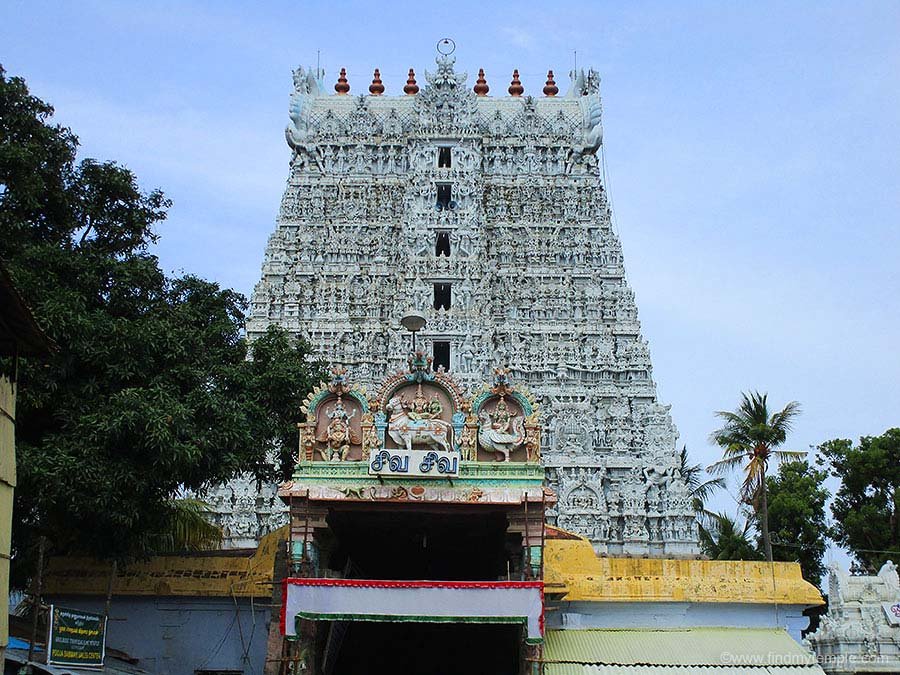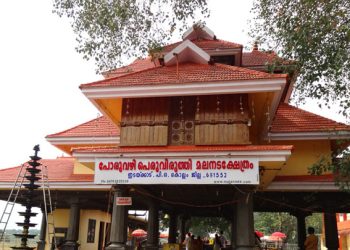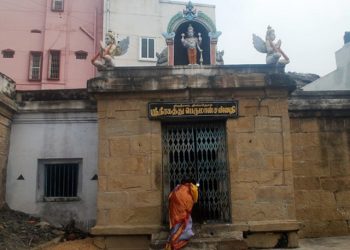The Thanumalayan Temple, also called Sthanumalayan Temple is an important Hindu temple located in Suchindram in the Kanyakumari district of Tamil Nadu, India.The Thanumalayan Temple is of importance to both Shaivaite and Vaishnavite sects of Hinduism, as the name Stanumalaya denotes Trimurtis; “Stanu” means Siva; “Mal” means Vishnu; and the “Aya” means Brahma
Shrine’s History
The current temple was built in the 17th century and is famous for its sculptures. It was previously controlled by the Nambudiris, one of the main Namboodiri families called the Thekkumon Madam. The main deity of the temple is Lord Shiva, Lord Vishnu and Lord Brahma in a single form called Sthanumalyam.This The 17th-century temple is famous for its architectural grandeur. The seven-storey white Gopuram is visible from the distance. Its 40 m facade is covered with sculptures of Hindu deities. The place got the name of Suchindrum from the Sthala Purana. Hindu mythological legend has it that king of devas, Indra got relieved of a curse at the place of the main linga in the temple. The term “Suchi” in Suchindrum is believed to have derived from the Sanskrit meaning that stands for “purify”. Accordingly, Lord Indra is supposed to visit the temple for performing “Ardhajama Pooja”, or worship, at midnight every day. Thirumalai Nayak and the Travancore Maharajas, under whose administration the temple remained till Kanyakumari’s merger with Tamil Nadu, have made many endowments for its upkeep. It is interesting to note that during the reign of Ayilyam Thirunaall Maharajah of Travancore, a lottery scheme was introduced in 1875 A.D., to raise funds for rebuilding a portion of the temple and a sum of over Rs. 40,000 was realised

Legends Associated with This Shrine
The temple’s religious significance lies in the embodiment of the divine trinity – Siva, Vishnu, and Brahma – within the main linga statue. This unique representation of the central gods of Hinduism sets this temple apart in India. Perhaps influenced by the diverse religious practices of the region, with Vaishnavism dominant in Padmanabhapuram and Shaivism prevalent among the Nanjil Pillais and other communities in Nagarcoil due to historical influences. The temple stands as a testament to the unity and diversity of Hindu beliefs, with deities spanning across the Hindu pantheon from Rama and Krishna to Amman and Kandan. Each idol within the temple reflects the various Hindu sects, from Vaishnavism and Shaivism to the more localized Tamil sects, creating a harmonious blend of faith and devotion.

Architectural Relevance of This Shrine
The temple stands as a remarkable architectural feat, renowned for its exceptional craftsmanship in stone. Of particular note are the four musical pillars sculpted from a single stone, towering at a height of 18 feet. These pillars, located within the Alankara Mandapam section, serve as a prominent architectural and design feature of the temple complex, producing a melodic symphony when struck. Additionally, the area known as the dancing hall boasts a staggering 1035 intricately carved pillars.
An impressive statue of Anjaneya, carved from a single granite block and towering at 22 feet, stands as one of the tallest of its kind in India. Notably, this statue was buried within the temple premises in 1740 out of fear of an attack by the Tipu Sultan, only to be rediscovered in 1930 and restored under the supervision of the esteemed Devaswom Board Commissioner Rajya Seva Praveena Sri M.K. Neelankantha Iyer of Kottarathu Mathom, Moncompu.
Furthermore, the temple houses a colossal Nandi statue crafted from mortar and lime, measuring 13 feet in height and 21 feet in length. This monumental sculpture ranks among the largest Nandi statues in India, adding to the historical and architectural significance of the temple.

Shrine’s Map Location and How to Go There
By Road
The nearest bus stop is Kanyakumari bus stand.
By Rail
Kanyakumari is very well connected to other parts of the country by train. The Kanyakumari railway station is located very close to the Kanyakumari bus stand. There are many trains starting from Kanyakumari, including a Rajdhani express. There are direct trains to Kanyakumari from all the four metropolitan cities of the country and also the major cities like Bangalore and Pune.
By Air
The nearest Airport is Trivandrum.

Events Celebrated at This Shrine
The 10-day Car Festival celebrated in this temple during between December and January every year attracts crowds of thousands of people. Another festival known as Teppam is celebrated during between April and May every year. The Sanskrit work Sucindrastalamahatmya gives a full-fledged legendary account of the origin and development of this temple.
Summary
The esteemed Thanumalayan Temple, also recognized as the Sthanumalayan Temple, stands as a significant Hindu sanctuary situated in Suchindram, within the Kanyakumari district of Tamil Nadu, India.
Eminent for its architectural splendor, the temple complex spans approximately two acres and is adorned with two majestic gateway towers known as gopurams. The eastern tower, standing tall at a height of 44 meters (144 ft) with 11 stories, is particularly noteworthy. Within the temple precincts, numerous shrines are present, with the sanctums of Sthanumalayan and Hanuman holding special prominence. Notably, the temple boasts four musical pillars intricately carved from a single stone, producing distinct musical notes when struck. Additionally, a mesmerizing dancing hall featuring 1,035 exquisitely crafted pillars adds to the allure of the temple.
The Thanumalayan Temple holds religious significance for both Shaivite and Vaishnavite sects of Hinduism, as denoted by its name Stanumalaya, symbolizing the Trimurti – “Stanu” representing Shiva, “Mal” signifying Vishnu, and “Ayan” denoting Brahma. Revered as one of the 108 Shiva Temples revered by Kerala Hindu culture, despite its current location in Tamil Nadu, the temple hosts six daily rituals spanning from 5:30 a.m. to 9 p.m., along with a multitude of annual festivals, with the Margazhi festival holding particular prominence.
Constructed during the Chola dynasty in the 9th century, the present structure of the temple underwent subsequent expansions attributed to Thirumalai Nayak and the Travancore Maharajas. The administration and upkeep of the temple are overseen by the Hindu Religious and Charitable Endowments Department of the Government of Tamil Nadu.
Nestled in Suchindram, Kanyakumari district, Tamil Nadu, India, the Thanumalayan Temple is easily accessible via public transportation from Nagercoil, located approximately 7 km away. For those arriving by air, the nearest airport is Thiruvananthapuram International Airport, situated around 75.8 km from the temple premises.













































